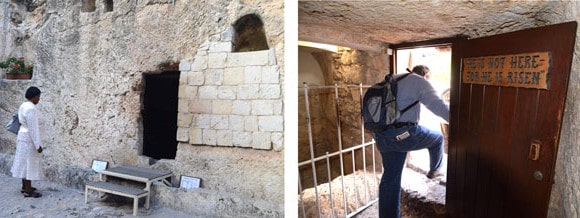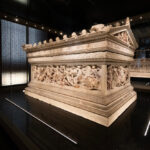In Search of Jesus’ Tomb
- At August 16, 2013
- By mausoleum
- In Doug Keister's Blog
 0
0

It is probably next to impossible to precisely plumb what tomb people most want to see. The Taj Mahal and the Great Pyramid of Giza are certainly contenders. But the majority of people do not go to those places because they want to see a tomb. They go there because of the history and architecture.
However, there is one burial place where people go specifically to see a tomb. The name of the person who supposedly occupied this tomb just might be the most recognizable name on Earth: Jesus of Nazareth.
Travelers to the Holy Land often hear the phrase ‘the tradition is.’ There are so many layers of history, buildings, events, and people that the whereabouts of specific historic sites have been lost to the ages. To be sure, the Mount of Olives, Garden of Gethsemane, the Sea of Galilee, the Jordan River, and Mount Zion are verifiable places. But other places are often referred to as the ‘traditional site’ such as the traditional site of the Last Supper and the traditional site of Jesus’ birth. Other sites have more than one traditional location. Such is the case with Mary’s place of ascension and Jesus’ tomb and place of ascension.
Since the fourth century, the Church of the Holy Sepulchre has been venerated by Christians as the site of Jesus tomb. Indeed, there is a large and elaborate mausoleum called The Aedicule inside the church that in said to be directly over Jesus’ burial spot. Not too far away, and still within the walls of the church is a large stone slab that is said to be where Jesus was anointed, as well as Golgotha, the spot where Jesus’ cross was erected.
In 1893, British citizen General Charles Gordon began exploring the idea that another site might be the actual location of Jesus’ tomb. That site is now commonly known as the Garden Tomb. Citing ancient laws that prohibited burials within the city walls (the Church of the Holy Sepulchre is within the walls), and quoting biblical verses that Jesus was buried in a rock-cut tomb in a garden, Gordon suggested a location for Jesus’ tomb that is outside the walls of Old Jerusalem.
Indeed, John 19:41 reads “Now in the place where he was crucified there was a garden; and in the garden a new sepulcher, wherein never a man was laid.” The Bible also contains references to Jesus being buried in a rock-cut tomb donated by Joseph of Arimethea that was in Joseph’s garden. (Note: gardens were a real luxury since they require water, a treasured commodity in a desert climate) Indeed, the garden where the Garden Tomb is located contains a cistern over 2000 years old.
And, Mark 15:22 reads “and they bring him to the place Golgotha, which is, being interpreted, ‘Place of a skull.’” Sure enough, a cliff face next to the garden looks like a skull in the right light.
If you journey to Jerusalem, make sure to visit the Garden Tomb. After entering the garden you will see a tomb carved into the wall in a style that was mentioned in the Bible, a channel in front of the tomb where a stone that would have covered the entrance would have been rolled, a two millennia-old cistern and a cliff-face that looks like a skull. Whether the tomb really contained the body of Jesus will probably never be known.
Text and copy © Douglas Keister Visit Doug’s Author Page
